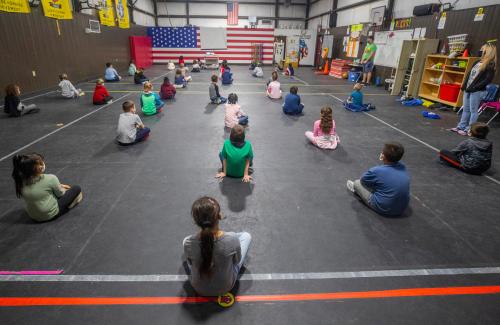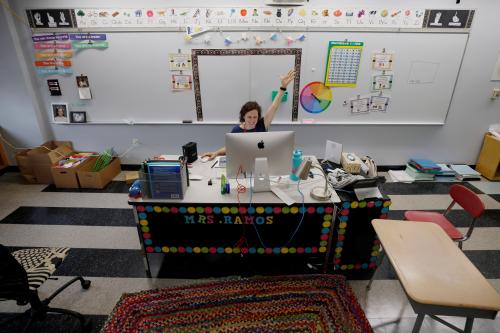Concern about our nation’s children is currently at the center of intense public debate. While the pandemic caused virtually all schools nationwide to close by April 2020—keeping almost all K-12 students home for the remainder of the 2019-20 school year—children’s mode of learning (fully in-person, fully remote, or a hybrid mix of the two) in 2020-21 has been highly variable.
Yet with vaccinations accelerating, COVID-19 rates falling, and money flowing, there is clear momentum behind offering in-person instruction. As schools begin to reopen, attention is turning to the deep changes necessary to reverse the learning opportunity disparities that are ingrained in U.S. education.
As educators consider possible changes, adults’ beliefs about the impacts of the pandemic on children’s academic progress—overall and for specific student subgroups—matter. These subjective opinions are important because they indicate political support, or lack thereof, for investment in education. Long-needed, fundamental, and sustained investments in and improvements to K-12 education—especially for underserved low-income and racial minority students—will need broad support. Beyond parents of elementary and secondary children and Democrats—those traditionally most supportive of investments in K-12 education—but from older and Republican voters, and from affluent as well as economically struggling voters.
To learn perspectives on children’s academic progress from adults with K-12 children in the household and from adults as a whole, we used data collected between Dec. 16, 2020, and Feb. 7, 2021, from a nationally representative sample of U.S. adults through the USC Dornsife Center for Economic and Social Research’s Understanding America Study. We asked how concerned adults were that today’s generation of K-12 students may not make as much academic progress this year as they would during a typical academic year. In addition to asking about concern for K-12 students overall, we asked separately about concern for students from lower-income households, students of color, elementary students, and middle/high school students.
The results were clear and overwhelming: Almost three-fourths (71%) of US adults are concerned about K-12 students’ current academic progress. Very few economic, political, or social concerns share this level of agreement in the population, implying policies and programs designed to address the negative impacts of the pandemic on schools could have broad support.
Given low-income communities and communities of color have been especially hard hit by the pandemic, schools in these neighborhoods will need even greater levels of resource and policy attention. We find even higher levels of concern for students in these groups: 81% of adults were concerned about lower-income children, and 77% about children of color.
Not only did we find levels of concern were high across the board, but we also found more advantaged groups were often more concerned about students’ academic progress (even when statistically controlling for an adult’s age, whether they have a K-12 child living in their household, adult race/ethnicity, household income, adult education level, and partisanship).
For instance, we found higher-income and more educated adults are more concerned—both overall and specifically about low-income students and students of color—than are low-income and less-educated adults. Seventy-four percent of adults in households making less than $25,000 are concerned about low-income children—lower than the corresponding rates for adults in households making $25,000-$150,000 (81-83% concerned about low-income children), and households making more than $150,000 (88%). As another example, greater proportions of adults aged 65 and older expressed greater levels of concern for low-income students and students of color, with 86% and 85% of adults over 65 concerned for each respective subgroup, compared to 77% and 72% concerned about these two student subgroups among adults aged 18-34. This is a promising pattern from an education policy perspective, as the unfortunate reality is that power to enact meaningful political change tends to be concentrated among the wealthiest and older individuals. These results suggest that those who tend to hold power may also have a will to enact meaningful, equity-based education policy in the wake of the pandemic.
We did not find racial differences. Regardless of their own race, adult Americans are equally concerned about the impacts of the pandemic for K-12 children.
Notably, too, we found high levels of bipartisan concern. Republicans (77%) and Democrats (70%) are concerned about K-12 children’s academic progress. Over 80% of Republicans and Democrats are concerned about lower-income children (81% Republicans, 84% Democrats) and close to 80% of each political group are concerned about children of color (76% Republicans, 82% Democrats). In other words, despite Congress’s partisan voting on the American Rescue Plan, there is widespread agreement that the effects of the pandemic on children are concerning.
In contrast, in 2019, relevant national survey results reflected much larger partisan differences on public education issues. For example, while 76% of Democrats thought education should be a top federal policy priority, 58% of Republicans felt the same. Also in 2019, 67% of Democrats supported or strongly supported basing part of teachers’ salaries on whether they teach in schools with many disadvantaged students, compared to 52% of Republicans.
What does this all mean? There may never have been more widespread, bipartisan concern about K-12 children’s educational progress, especially among adults without a K-12 child in the home. Unjust as it may be, political will to mobilize change often rests with more affluent and more educated groups. It also typically requires at least some degree of bipartisan agreement. The vast majority of affluent adults, and those from both sides of the political aisle, are concerned for K-12 children—particularly those who have been underserved. As districts and schools reopen, with leaders designing and rolling out new initiatives, they will likely find widespread encouragement.
The authors gratefully acknowledge financial support from the National Science Foundation Grants No.2037179 and 2120194. Any opinions, findings, and conclusions or recommendations expressed in this material are those of the authors and do not necessarily reflect the views of the National Science Foundation. The authors are also grateful to Marshall Garland, Shira Korn Haderlein, and the UAS administration team for their contributions to this work.









Commentary
Almost everyone is concerned about K-12 students’ academic progress
March 23, 2021